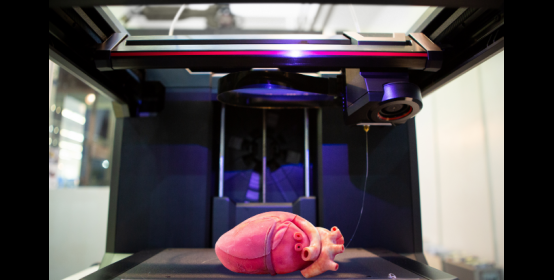
The complexity of the human body has always been an obstacle for people who need organ transplants. There isn't an easy way to fabricate a liver or heart the way you can create a prosthetic arm or leg, for example. In recent years, 3D printing has presented an interesting new way to create complex biological structures by setting down precise, carefully controlled layers of biomaterials. Different printing methods offer scientists ways to create organs for transplantation, or even for the study of diseases that are typically beyond the reach of observation. This has incredible implications for patients.
There are a lot of ways to 3D print something. Here, we're specifically talking about “bioprinting,” which is the process of printing something using materials called bioinks. Bioinks are made up of living cells, biomolecules, or biological materials. Just like other forms of 3D printing, bioprinting involves depositing layers of bioinks into a predetermined form.
There are currently three different methods of bioprinting. One is extrusion-based bioprinting, which involves dispensers that squeeze out bioinks in continuous filaments. Droplet-based bioprinting uses electric, thermal, or sound-based stimulation to form droplets of bioink. Laser-based bioprinting uses lasers to carefully position cells. Each of these methods requires specialized bioink with different physical, chemical, and biological characteristics.
Bioprinting can be a fairly lengthy process, but would still be faster and more reliable than waiting for a transplant. The printing itself takes a few hours, but the entire process from cell harvesting to implantation could take as many as six weeks.
There are many diseases and medications that are difficult to observe in action. In vitro studies involve using cell cultures in glass, but this isn't an entirely accurate model of how pathogens or drugs behave in the body. In vivo studies have their own limits, including the challenges inherent in trying to observe how organ systems function in a living organism, on a cellular level, in real time. Bioprinted organs give scientists a way to model and study disease processes.
Bioprinting is also a major breakthrough for transplant patients. Receiving a transplant involves finding a potential donor, ensuring that the donor is a match for the recipient, obtaining the organ, implanting it into the recipient in time. After that, the recipient still has to be on immunosuppressant medications for life. These come with dangerous side-effects, and there's still a risk of rejection.
Since bioprinting can fabricate a new organ from the transplant recipient's own cells, there's virtually no risk of rejection. This means that transplant surgeries are likely to be more successful, there's no need for dangerous immunosuppressants, and the transplant surgery may not need to be repeated years down the line.
Right now, there are still a lot of obstacles in the way of viable 3D printed organs. Researchers estimate a timeline of a decade or more. This is because not only does the technology need to be refined, but it needs to go through FDA approval. Bioprinting is very promising, but it remains to be seen if bioprinted organs are safe and successful for actual, living patients.
Each day, almost 20 people die waiting for an organ transplant. The ability to bioprint organs means that there's no need for people to die due to a lack of available organs. They don't need donors, since organs can be fabricated as needed.
Still more people die after receiving transplants. This can happen due to organ rejection, graft-versus-host disease, or simply due to the fact that transplants tend to fail over time. For example, the graft half-life of a kidney from a living donor is about 10 to 13 years.
For patients, the implications of 3D printed organs are overwhelmingly positive. The death rates for people pre- and post-transplant are likely to drop significantly. The quality of life for transplant recipients is also likely to improve, as anti-rejection medication won't be necessary if the bioprinted organs are made from the recipient's own cells.
Bioprinting is also likely to dramatically decrease the cost of transplants. Treating organ failure is very expensive, and the average cost of a kidney transplant is over $400,000. Even considering the cost of harvesting cells, refining them, storing them, and the equipment needed to fabricate a new organ, bioprinting is likely to be less expensive than conventional transplantation.
Even though it'll be a while before 3D printed organs are an option for patients, researchers are very optimistic. Even if this technology doesn't receive FDA approval and become a treatment option, it will still be an invaluable resource for medical researchers. The ability to print organs layer-by-layer will give them an unprecedented view into complex organs, leading to a better understanding of diseases and new breakthroughs in treatment.